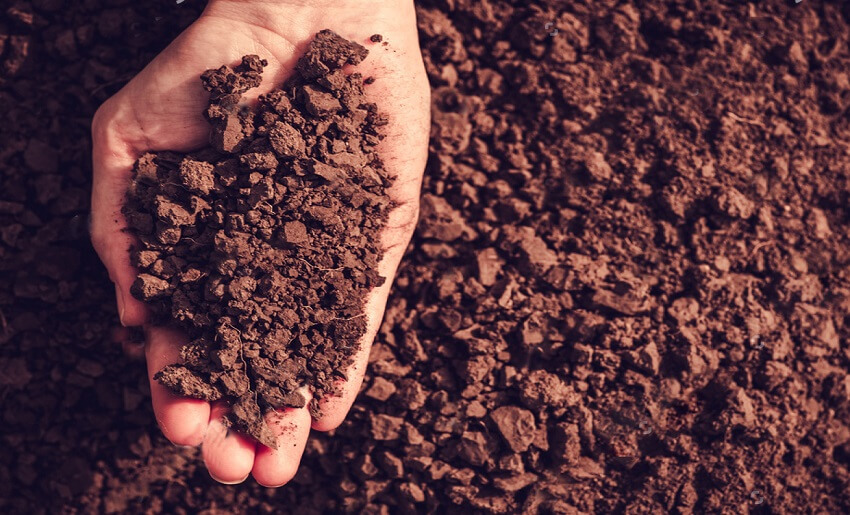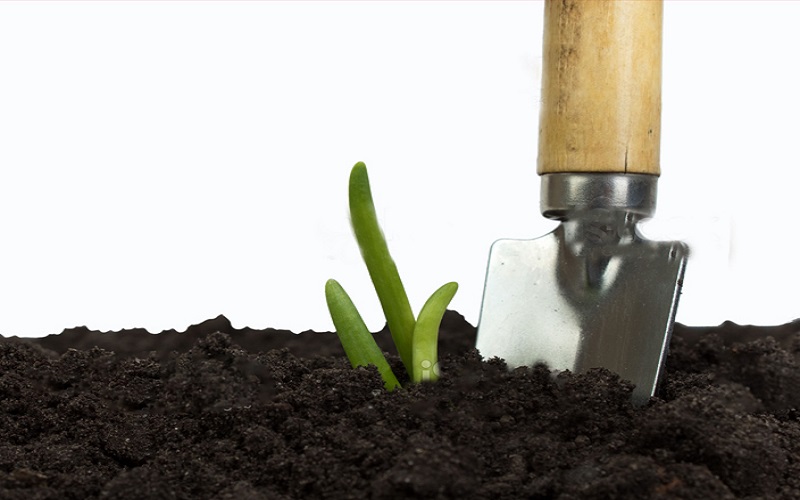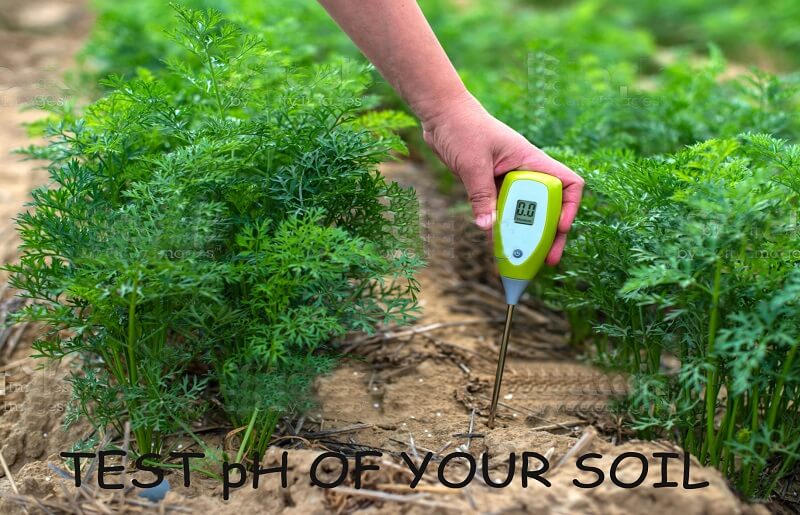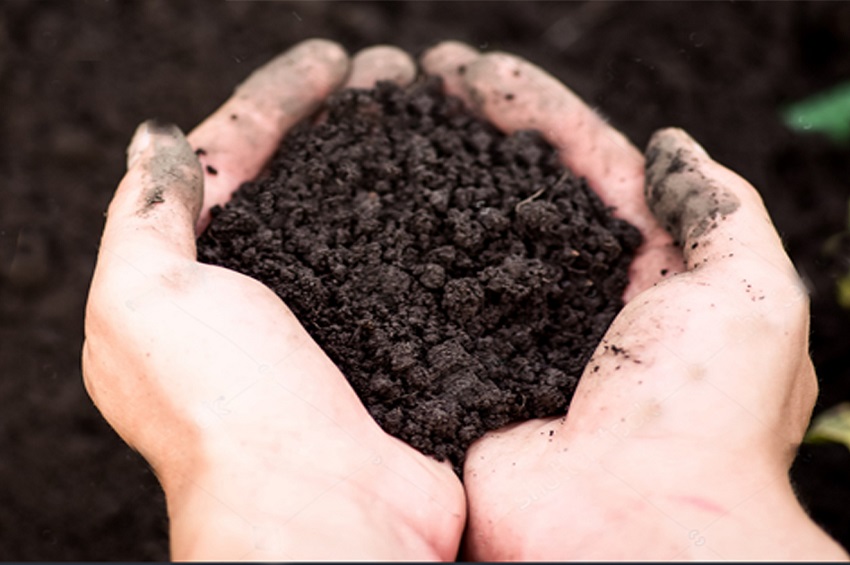This post was last updated on May 5th, 2021 at 09:43 pm
Having healthy soil is the most important ingredient in creating a successful and productive garden. When you have healthy soil, your plants will grow vigorously, be free of disease, produce more fruit, hold more air/water, and be resilient to adverse climatic conditions.
In contrast,
Trying to cultivate a garden in inadequate healthy soils will result in stunted discolored plants that will be prone to disease and produce an inferior yield. Unfortunately, large parts of the world have soils that are inadequate for gardening because they have been disturbed by man or occur on unfavorable geologic/climatic conditions. It is likely that if you would like to start a garden your first step will be figuring out how to prepare the soil for gardening.
You do this by bringing your soil to life with organic matter and a whole array of beneficial microorganisms that will work in unison with your plants. You must re-transform your soil to hold air, water, and the life giving nutrients necessary for vital and fast growing plants. By properly fertilizing your soil with compost, biochar, and the proper fertilizers you bring fertility to a nutrient-deficient landscape and begin a productive garden. In the following text, you will read exactly everything you need to know on how to prepare soil for gardening.
Types of Soil and their Foundational Components
Soils are composed of two main solid components; a mineral component and an organic component. The mineral component refers to materials of non-living origin. Here we have sediments like sand, silt, and clay but also minerals that may be free-living molecules and important plant nutrients. Most soils you will encounter are over 95% mineral.
The second component, while much less abundant by volume, plays an incredibly important role in determining the health of your soil. In this context, the “organic component” or “organic matter” refers to the fact that these are materials that are alive or were of living-origin, and not related to organically certified products.
As previously explained soils are mostly composed of sediments consisting of sand, silt, and clay. These originate from a “Parent Material” which consists of different rock types from different origins that each have unique properties and mineral nutrients. As these large masses of rock are broken down into smaller pieces they become boulders, cobbles, gravels, and eventually sediments of sand, silt, and clay. Each of these sediments has unique properties as will be explained shortly.
Soils are composed of different quantities of these sediments leading to different types of soils. The proportions of sand, silt, and clay is known as your soil texture. When soil has an even quantity of each sediment they are known as “Loams” and are the most useful agricultural settings.

Sandy Soils
Sand is the largest-sized sediment and produces soils with-
- High drainage
- Low water retention
- Low nutrient holding
- Highest bulk density and
- Largest pore size.
The large pore size increases its ability to hold air and creates an easily permeable texture that allows water to drain. Sandy soils are beneficial when well amended and in climates with heavy rains. In contrast, these soils are not particularly valued in arid areas because they hold less water and are more easily prone to drying out. Sandy soils are common on slopes and in mountainous areas. Coastal regions may also have sandy soils.
Silty Soils
Silt is of intermediate size and characteristics. You can easily identify silty soils because when dry they have a very powdery consistency that is prone to be blown by the wind or form “dust clouds”. When wet they have a velvety consistency. Silty soils were often formed by the deposition of silts on the flood plain of a river, they may have been deposited recently or many hundreds of years ago. Certain land-forms also accumulate silts that were carried by winds and deposited in these locations.
Clayey Soils
Clay is the finest sediment and generally has
- low drainage
- high water retention
- low bulk density
- high nutrient holding capacity
- heavily compacted.
The biggest issue with clay soils is their lack of drainage that can create anaerobic (lacking oxygen) conditions that result in disease. When compacted their impermeability greatly increases, resulting in even lower drainage, and can have devastating effects on the health of your plants.
Clays do have an ability to retain nutrients, making it a preferable quality for some plants. In arid climates, these soils are beneficial because of their ability to retain moisture and slow the drainage. Clay can be easily identified in soils because its sticky and easily be shaped into a ball that will hold its shape. Certain types of clay have shrink-swell properties meaning they shrink when dry and swell when moist. These can be particularly difficult to work with and can even hold water and nutrients so well that it becomes inaccessible to plants.
Loam Soils
As previously explained, Loams are soils that are an even mixture of sand, silt, and clay. They are highly valued in agriculture because they share the beneficial properties of each sediment with less of their detrimental qualities. Different types of loam also exist and may be beneficial in different environmental settings. For example, in a very wet climate, you may prefer to have a Sandy Loam because of the improved drainage and porosity. In contrast, you may prefer a clayey loam in Arid environments where water retention is crucial to meet your plant’s water needs.
Test your soil type
Testing to determine the texture and the type of soil you have is easier than you may think. It doesn’t require any fancy equipment or even sending it in to a lab. You can actually use the sense of feel and test the physical properties of your soil with no more than your hands to determine the texture of your soil.
Soils with sand will be gritty, clay soils sticky, and silty soils very smooth and velvety.
This process is known as “texturing by feel”. Very sandy soils can be easily identified because of their inability to be shaped into a ball that sticks together. If your soil does form a ball when shaped than you must do a ribbon test. Making a ribbon is simply taking a piece of your soil, forming it into a ball and then squeezing it between your thumb and your forefinger. Squeeze upward as far as you can to make a ribbon. If you were able to shape a ball but no ribbon then you have a loamy sand. If your ribbon is longer than 2.5 cm then you know you have a loam or a clay soil. If you excessively wet your soil and rub it between two fingers you can also feel for sediments.

Features of Healthy Soil
1. The Organic Component
As formerly mentioned most soils are mostly mineral-based and consist of less than 5% organic content. Again to clarify this usage of the word “organic” just refers to living or previously living materials such as rotting vegetation and microorganisms, this has nothing to do with “chemical-free” organic products.
This component is composed of decomposing materials (wood, leaves, vegetation), that over time are broken down into their most basic form known as humus. Humus is a fine, dark, somewhat sticky material that you may be familiar with if you’ve worked with compost or worm castings.
Humus is important for soil fertility because it has an enormous ability to retain nutrients, water, and biological organisms crucial to your soil health. These living biological organisms (like fungi, bacteria, protozoa, amoebas, nematodes, and worms) are incredibly important to your soil’s health because they cycle nutrients, deter harmful pathogens, and form symbiotic relationships with your plants. Making sure you have the proper content of organic-matter is the first thing you’ll do when learning how to prepare your soil for gardening.
2. Air and Water
Like most terrestrial life, flourishing soil needs to have a healthy supply of air and water to create a thriving environment for plant roots. While most people know plants need water, most also need oxygen (both above and below ground) to conduct the cellular respiration needed to live. Anaerobic conditions (lacking oxygen) not only prevent your plant roots from breathing but also promote the growth of detrimental microorganisms in your soil. Some of these microorganisms will remove important nutrients from your soil (through the process of denitrification) while others will be directly harmful to your plants. These issues will be most common in clay soils, particularly if compacted or in wet environments. Soils with large pores (like with sand) tend to have better breath-ability.
A general rule of thumb suggests you want about 25% air and 25% water by volume in your soil to maximize the productivity of your plants.
3. Soil Nutrients
Plants depend on nutrients that they absorb from the soil through their roots. The three most important plant nutrients are Nitrogen (N), Phosphorus (P), and Potassium (K). These three are sometimes grouped and abbreviated as N-P-K. These are also sometimes referred to as the “most limiting” nutrients because they are commonly the least available nutrients in the soil that will inhibit plant growth. These three nutrients as known as “macro-nutrients” because they are required by plants in large numbers. Other essential macro-nutrients include calcium (Ca), sulfur (S), magnesium (Mg), carbon (C), oxygen (O), and hydrogen (H).
In contrast, there are also “essential micro-nutrients” (also known as trace minerals) needed by plants in much smaller quantities. While only needed in smaller quantities, they are also crucial and can limit or inhibit plant growth if not readily available. The main essential micro nutrients are iron (Fe), boron (B), chlorine (Cl), manganese (Mn), zinc (Zn), copper (Cu), molybdenum (Mo), and nickel (Ni).
Nitrogen is typically the most limited and important nutrient in your soil. While nitrogen gas comprises 70% of our lower atmosphere, it is scarcely found in soils and must be bound into specialized compounds that are available for your plants. This happens through the process of nitrogen fixation that is executed by particular microorganisms known as “Nitrogen Fixing Bacteria”. The specialized bacteria are most often associated with the roots of certain plants, most notably members of the bean family, and are responsible for 99% of plant-available nitrogen.
Symptoms of nitrogen deficiency can be seen in stunted plants with discolored leaves.
Discoloration occurring from the bottom and oldest leaves happen as your plant is taking nitrogen from these leaves and diverting it towards its new growth. This is a clear indication of nitrogen deficiency when compared to other patterns of discoloration that may be caused by other issues.
Natural materials high in nitrogen are manures, green vegetation, leaves, fruits, and kitchen scraps. When nitrogen-rich materials are mounded to make compost they will create an environment thriving with microorganisms that can heat up to 170 degrees Fahrenheit. While plants generally love nitrogen, you must be careful when applying nitrogen-rich materials or fertilizers to your soil because this can be detrimental and cause leaf discoloration.
Phosphorus is the second most limiting nutrient in soils and is of mineral origin. Phosphorus comes from the weathering of phosphorus-rich rocks that release it into more biologically available forms into the soil. Phosphorus is essential for photosynthesis, flowering, and the production of fruit. While many soils may have sediments composed originating from phosphorus-containing rocks, it is often unavailable to plants. There are certain plants known as phosphorus accumulators that are particularly effective at absorbing this hard to get phosphorus and absorbing it into their tissues. These plants can be used to create phosphorus-rich composts. Other natural materials high in phosphorus include different manures (swine and poultry), bone-meal, and pulverized phosphate rock.
4. Microorganisms
Microorganisms are some of the most important features of your soil’s health and when in balance can have extremely beneficial impacts on the health of your plants. Many microorganisms are involved in the process of nutrient cycling.
Nutrient cycling is the process of taking complex compounds found in living vegetation and rocks and breaking them down into simpler plant-available nutrients.
This often takes place as specialized microorganisms consume these complex materials and release simpler compounds as their waste product. These organisms themselves also contain nutrients in their cells that are released when they die or are consumed by other organisms.
Almost all plants are associated with microorganisms that form symbiotic relationships directly with their roots.
This specialized ecosystem maintained by plants around their roots is known as the rhizosphere and is crucial to your plant’s health. Plants maintain the rhizosphere with specific microorganisms by feeding them with specialized sugars in the form of root exudates. These microorganisms either specifically help with the acquisition of nutrients or work as a defense system by deterring harmful microorganisms.
Fungal mycorrhiza are an important part of the plant’s microbiome and are found in 95% of plants. These fungi exist inside the roots of plants and the surrounding soil and help mobilize soil nutrients into the roots. Because strands of fungal hyphae are hundreds of times smaller than plant roots, they increase the surface area available for nutrient absorption by thousands of times.
The absorption of phosphorus in particular is greatly increased by the presence of mycorrhizae. The mycorrhizae also surround plant roots and act as a defense mechanism by creating a protective barrier around the plant roots.
5. pH; Why Acidity Matters
The pH of your soil is an important factor that can heavily affect the health of your soil regardless of its fertility. Even if your soil is full of nutrients, your plants will be unable to absorb any of these nutrients if it does not have the proper pH. Your ideal soil pH is around 6.8-7.0 but will depend on the crop you are cultivating.

Acidic soils have low pH (below 7) while alkaline soils have a high pH (above 7). Before attempting to raise or lower your soil pH it is recommended to perform a proper test to see the true pH of your soil. In some regions, it can be safe to assume your pH because of large scale environmental conditions.
For example,
Tropical soils are typically acidic while those originating from limestone will be alkaline. If you want to ensure a pH test can be easily done using one pH strips. A pH strips works by exposing it to a liquid solution and waiting for it to change color. The specific color that ends up on the strip depends on the pH. You can easily do this by mixing a small amount of soil with distilled water (or any pH neutral water) and inserting the end of your pH strip. You pH strip kit will come with a guide to help indicate the pH associated with the color that appears.
Groundwork for Soil Improvement
Unless you’re really lucky, your soils do not have ideal conditions for plant growth. Fortunately, there are many different ways to go about restoring the health of your soil. These will help increase your drainage and breathability all while also maintaining healthy water holding capacity. You can bring healthy microorganisms and fertility to your soil by just following some simple practices mentioned bellow:
Compost
One of the quickest, easiest, and most effective ways of improving your soil fertility is by adding dark nutrient-rich compost to your soil. While many people offer compost nowadays there are varying qualities when it comes to compost. Always look for dark, homogeneous, finely decomposed compost. Avoid compost with any large chunks of matter because these have not fully decomposed and may be void of nutrients.
If you notice compost is hot then don’t use it directly on your plants as it can cause root and foliar damage to your plants.
You can let this age until it cools down if necessary. Ideally, find compost that is a bit moist to ensure it is still full of healthy living microbes. Dry powdery compost is often lacking in microbial life and if the compost seems overly saturated it may be housing unwanted microorganisms. Finally, make sure your compost has a neutral smell.
To apply your compost you can either mix it into your soil before planting or apply it on top as a “top dressing”. When top dressing make sure to cover with at least a thin layer of mulch to prevent all the good nutrients from evaporating and prevent the sun from killing the beneficial microbes. If you already have mulch present than move it to the side, place compost, and then cover.
Mulch
Mulch is one of the most efficient ways to improve soil conditions and fertility. Mulch is essentially a layer of organic matter that is placed above the soil surface around the base of plants. Mulch provides many different benefits to your soil and is recommended in all climates.
Mulch can be composed of wood chips, leaf litter, hay, straw, agricultural waste, or just chopped up vegetation. It has a wide variety of advantages like–
- Mulch protects the soil from heavy rains that can cause erosion and unwanted splashing.
- It also protects the surface of the soil from the sun’s UV rays that kill and sterilize the soil.
- This also keeps the soil temperature cooler which is more favorable for plant growth.
- As the mulch breaks down it feeds soil microbes and adds organic matter and fertility to the soil.
- Mulch also helps to retain moisture in the soil by reducing evaporation.
Certain mulches are known as green mulch because they are made from green herbaceous vegetation that quickly breaks down and adds fertility to your soil. These are also known as green manure. Because sunlight damages most microbes and causes nutrients to evaporate it is often recommended to top any green mulch with a brown mulch like wood chips or dried leaves to retain these nutrients. Using green mulches can be one of the easiest ways to amend your soil because you’re often using vegetation that is readily available that would otherwise go to waste or be sent to a compost pile. Many people plant specific plants around their main crops that serve as quick and handy green manure.

Compost Tea
Compost tea is created by taking nutrient-rich compost or worm casting and brewing it into an oxygenated tea with molasses. You can easily make compost tea at home by taking 3-4 cups of compost, placing it in a compost tea bag (or wrapped in fabric works), and letting it sit in a 5-gallon bucket of water mixed with 2 tablespoons of molasses.
For the most effective and microbial rich tea place the best aquarium aerator available or a compost tea bubbler inside the bucket. This promotes the growth of beneficial air loving microbes. Apply this compost tea regularly during watering. You can even take this tea and use it as a beneficial foliar spray.
Biochar
Biochar is perhaps one of the most powerful and effective ways to improve the fertility of your soil. While relatively unheard of by many people biochar is considered by some the future of agricultural amendments. The secret is in the physical properties of charcoal that have magnetic sponge-like properties that allow it to soak up large quantities of nutrients and water. It’s for this same sponge-like property that we use it in water filters.
By placing biochar in a nutrient-rich solution you are activating it with nutrients that are held tightly by the biochar. When applied to your soil biochar will slowly release these nutrients over time while also recharging as it absorbs any additional nutrients or fertilizers you may be adding to your soil.
Biochar also helps with drainage while also holding moisture! Last but not least, the high-surface-area molecular structure of biochar provides for a luxurious home for beneficial microorganisms that live in your soil.
Need of Chemical Fertilizers
While chemical fertilizers can be used to improve yields they must be used with caution as to not damage your soil. Apply chemical fertilizers in small quantities only when necessary and based on the needs of your plants.
Chemical fertilizers are most often composed of the three main macro-nutrients discussed earlier, Nitrogen (N), Phosphorus (P), and Potassium (K), widely known as N-P-K ratio. The fertilizers will be labeled with three numbers (like 10:15:10) that correspond to these nutrients. Different plants and different soils will require different proportions of each nutrient. Lawns, for example, enjoy 3:1:2 fertilizers while tomatoes prefer 10-15-10. Beans on the other hand often require less nitrogen and thus prefer fertilizers like 5:10:10. Investigating the needs of your specific plant will maximize the efficiency of using chemical fertilizers and promote the best growth. Always follow proper directions when using chemical fertilizers and avoid over-fertilizing or exposing these fertilizers directly to your plant roots. This can “burn” your plants and cause more harm than good!
Depending on your plant and type of fertilizers you are using you will need to develop a different schedule.
Water soluble fertilizers can be applied every 2-3 weeks during the growing season of the plant.
A granular or pellet fertilizer is released slower so may only be necessary every 6-9 weeks. Slow release fertilizers are also a great option and sometimes only need to be applied after planting. For long lived plants and perennials this could be done every 4-5 months.
Liquid fertilizers are best applied diluted into a watering container or a pressurized sprayer. Granular and slow release fertilizers are typically applied above the soil surface and then covered with more soil, compost, or mulch. It is important to follow the directions mentioned in what ever fertilizer you buy to ensure the best results. Stopping a fertilizer treatment can also stress your plants so make sure to continue with your treatment until after fruiting.
Overusing nitrogen fertilizers also can quickly deteriorate the health of your soil. Soils with an excess of nitrogen will begin to lose their organic matter and may turn acidic. This is something to consider if you want to make a long term commitment to improving your soil quality.
Tilling
Tilling is a common agricultural practice that is done to break up and mix the surface of your soil and improve its qualities.
This is often how you prepare soil for gardening. It is often done with a tractor but can also be done with a shovel, hoe, pick, or sturdy pitchfork. Tilling is useful to break up tough massive soil, increasing oxygen availability and permeability of water. It also makes it easier for your plant roots to spread their tender roots into the soil. It is often done before planting and can be done in unison with mixing in compost.
Somethings to note when tilling.
- Avoid doing this when the soil is saturated because it can have detrimental effects on your soil structure and make it more compact.
- Tilling is most effective as a surface layer treatment at less than 12” deep
- Any deeper can mix in lower quality soil to your topsoil and have a detrimental effect. A new trending strategy is the “no-till farming” where you avoid tilling your soil and let the plant roots and microbes do all the work.
If left undisturbed most soils will begin forming a beneficial soil structure and composition that will be damaged by tiling. In this strategy, you simply top-dress your compost and other amendments and let them slowly become incorporated into your soil.
pH Neutralization
There are many options when it comes to lowering your pH in alkaline conditions. Two of the fastest most trusted methods are by applying iron sulfate {Fe2(SO4)3} or aluminum sulfate{Al2(SO4)3} to your soil. This is typically done at around 5 pounds per 100 square feet but it all depends on your context. Another option for smaller spaces is mixing in peat moss or other organic matter which will slowly lower the pH of your soil. To raise the pH of your soil you can incorporate limestone or hydrated lime. Other natural materials include crushed seashells, wood ash, bone meal, and other calcium-rich materials.
Conclusion
Regardless of the soil you are working with, there are many options when it comes to how you “prepare your soil for growing vegetables” is first important to know the current conditions of your soil before you make any attempts to alter its properties. Once you’ve analysed its texture, pH, organic matter content, and gotten to know your soil you can begin to bring life back into your soil. You can take any soil and bring proper drainage and breath-ability while still having healthy water holding capacity. You can bring the organic matter and nutrients important for the symbiotic microorganisms that will feed and protect your plants. You can re-balance your pH and amend your soil with the long lasting nutrient holding capacity of biochar. Don’t feel limited by your soil, because know that with the proper resources you can bring fertility and abundance to a desert! The secret is all in building, restoring, and properly managing your soil!
